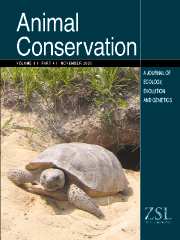Crossref Citations
This article has been cited by the following publications. This list is generated based on data provided by
Crossref.
Ostrowski, Stéphane
Williams, Joseph B.
Bedin, Eric
and
Ismail, Khairi
2002.
WATER INFLUX AND FOOD CONSUMPTION OF FREE-LIVING ORYXES (ORYX LEUCORYX) IN THE ARABIAN DESERT IN SUMMER.
Journal of Mammalogy,
Vol. 83,
Issue. 3,
p.
665.
Strauss, W. M.
2002.
Towards the effective management of the Arabian oryxOryx leucoryx in the Kingdom of Saudi Arabia.
Zeitschrift für Jagdwissenschaft,
Vol. 48,
Issue. S1,
p.
7.
Mésochina, Pascal
Bedin, Eric
and
Ostrowski, Stéphane
2003.
Reintroducing antelopes into arid areas: lessons learnt from the oryx in Saudi Arabia
.
Comptes Rendus. Biologies,
Vol. 326,
Issue. S1,
p.
158.
YOKOMIZO, HIROYUKI
YAMASHITA, JIN
and
IWASA, YOH
2003.
Optimal Conservation Effort for a Population in a Stochastic Environment.
Journal of Theoretical Biology,
Vol. 220,
Issue. 2,
p.
215.
Ostrowski, Stéphane
Williams, Joseph B.
and
Ismael, Khairi
2003.
Heterothermy and the water economy of free-living Arabian oryx (Oryx leucoryx).
Journal of Experimental Biology,
Vol. 206,
Issue. 9,
p.
1471.
Tenhumberg, Brigitte
Tyre, Andrew J.
Pople, Anthony R.
and
Possingham, Hugh P.
2004.
DO HARVEST REFUGES BUFFER KANGAROOS AGAINST EVOLUTIONARY RESPONSES TO SELECTIVE HARVESTING?.
Ecology,
Vol. 85,
Issue. 7,
p.
2003.
TENHUMBERG, BRIGITTE
TYRE, ANDREW J.
SHEA, KATRIONA
and
POSSINGHAM, HUGH P.
2004.
Linking Wild and Captive Populations to Maximize Species Persistence: Optimal Translocation Strategies.
Conservation Biology,
Vol. 18,
Issue. 5,
p.
1304.
Ostrowski, Stéphane
Williams, Joseph B.
Mésochina, Pascal
and
Sauerwein, Helga
2006.
Physiological acclimation of a desert antelope, Arabian oryx (Oryx leucoryx), to long-term food and water restriction.
Journal of Comparative Physiology B,
Vol. 176,
Issue. 3,
p.
191.
DEREDEC, Anne
and
COURCHAMP, Franck
2007.
Importance of the Allee effect for reintroductions.
Ecoscience,
Vol. 14,
Issue. 4,
p.
440.
Harding, Lee E.
Abu-Eid, Omar F.
Hamidan, Nashat
and
al Sha'lan, Ahmad
2007.
Reintroduction of the Arabian oryxOryx leucoryxin Jordan: war and redemption.
Oryx,
Vol. 41,
Issue. 4,
p.
478.
Hayward, Matt W.
and
Kerley, Graham I.H.
2009.
Fencing for conservation: Restriction of evolutionary potential or a riposte to threatening processes?.
Biological Conservation,
Vol. 142,
Issue. 1,
p.
1.
Johnson, Heather E.
Scott Mills, L.
Wehausen, John D.
and
Stephenson, Thomas R.
2010.
Combining ground count, telemetry, and mark–resight data to infer population dynamics in an endangered species.
Journal of Applied Ecology,
Vol. 47,
Issue. 5,
p.
1083.
Treydte, A.C.
Salvatierra, A.
Sauerborn, J.
and
Lamers, M.
2011.
Modelling llama population development under environmental and market constraints in the Bolivian highlands.
Ecological Modelling,
Vol. 222,
Issue. 17,
p.
3157.
Cunningham, Peter Low
and
Wronski, Torsten
2011.
Sex ratios of Arabian Sand Gazelle Gazella marica Thomas, 1897 in the Mahazat as-Sayd Protected Area, Saudi Arabia.
mammalia,
Vol. 75,
Issue. 3,
Wronski, Torsten
Lerp, Hannes
and
Ismail, Khairi
2011.
Reproductive biology and life history traits of Arabian oryx (Oryx leucoryx) founder females reintroduced to Mahazat as-Sayd, Saudi Arabia.
Mammalian Biology,
Vol. 76,
Issue. 4,
p.
506.
Ismail, K.
Kamal, K.
Plath, M.
and
Wronski, T.
2011.
Effects of an exceptional drought on daily activity patterns, reproductive behaviour, and reproductive success of reintroduced Arabian oryx (Oryx leucoryx).
Journal of Arid Environments,
Vol. 75,
Issue. 2,
p.
125.
Williams, Joseph B.
Shobrak, Mohammed
Wilms, Thomas M.
Arif, Ibrahim A.
and
Khan, Haseeb A.
2012.
Climate change and animals in Saudi Arabia.
Saudi Journal of Biological Sciences,
Vol. 19,
Issue. 2,
p.
121.
Champagnon, Jocelyn
Elmberg, Johan
Guillemain, Matthieu
Gauthier-Clerc, Michel
and
Lebreton, Jean-Dominique
2012.
Conspecifics can be aliens too: A review of effects of restocking practices in vertebrates.
Journal for Nature Conservation,
Vol. 20,
Issue. 4,
p.
231.
Hejcmanová, Pavla
Vymyslická, Pavla
Zácková, Magdalena
and
Hejcman, Michal
2013.
Does Supplemental Feeding Affect Behaviour and Foraging of Critically Endangered Western Giant Eland in anex situConservation Site?.
African Zoology,
Vol. 48,
Issue. 2,
p.
250.
Schulz, Ellen
Fraas, Sven
Kaiser, Thomas M.
Cunningham, Peter L.
Ismail, Khairi
and
Wronski, Torsten
2013.
Food preferences and tooth wear in the sand gazelle (Gazella marica).
Mammalian Biology,
Vol. 78,
Issue. 1,
p.
55.


